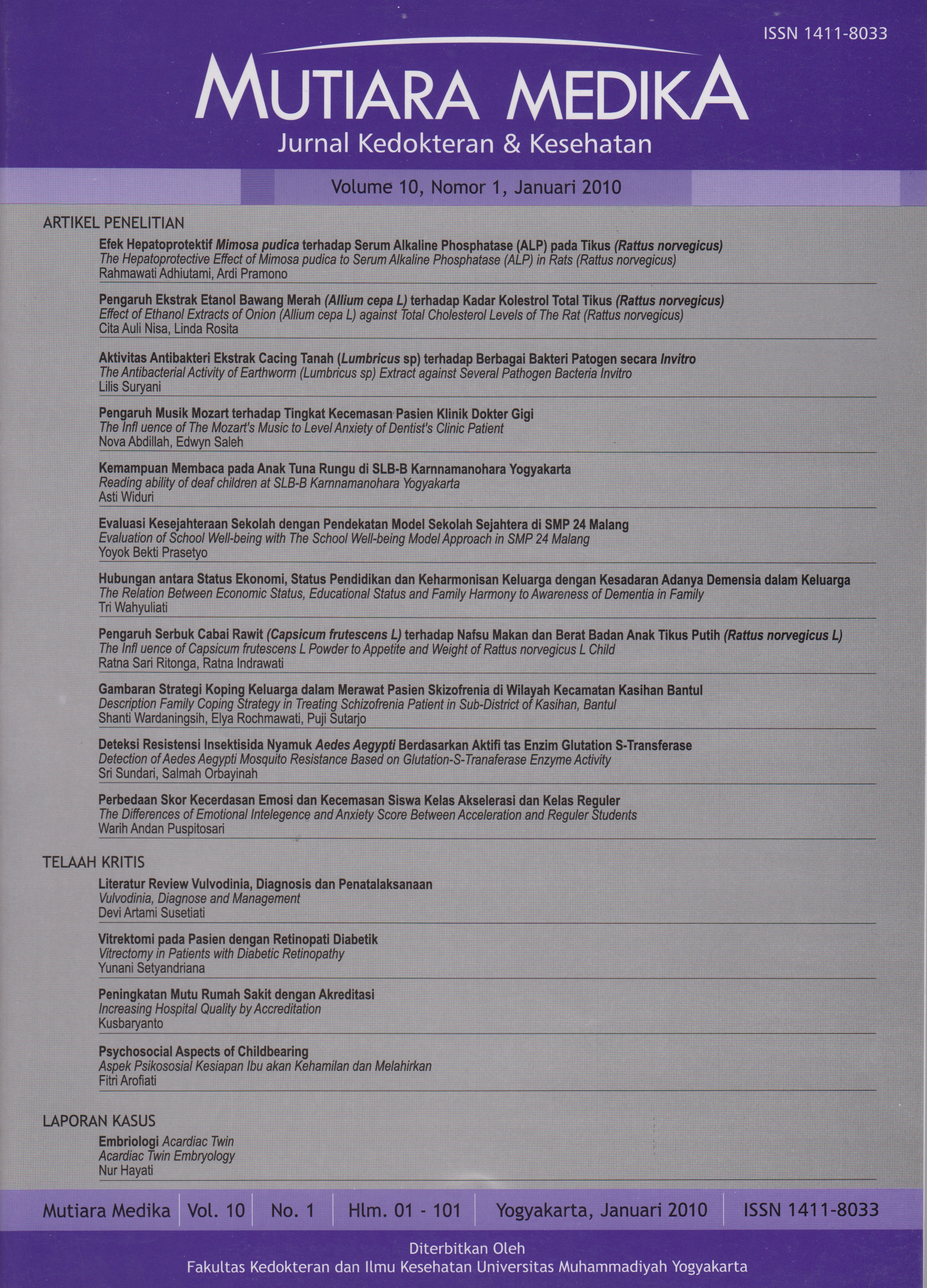Psychosocial Aspects of Childbearing
DOI:
https://doi.org/10.18196/mmjkk.v10i1.1568Keywords:
Aspek psikososial, kesiapan ibu akan kehamilan dan melahirkan, keperawatan, psychosocial aspects, childbearing, nursingAbstract
Salah satu isu nasional dalam bidang kesehatan adalah tindakan pencegahan terhadap masalah yang berhubungan dengan kesehatan ibu dan anak. Aspek psikososial merupakan salah satu faktor yang mempengaruhi kesiapan ibu akan kehamilan dan kelahiran (mempunyai anggota keluarga baru). Kehamilan dan kelahiran merupakan kejadian yang berhubungan dengan pengalaman manusia secara bio-psiko-sosial dan budaya. Respon ibu terhadap kehamilan dan kelahiran berbeda-beda, dipengaruhi oleh umur, kesehatan, status sosial ekonomi dan latar belakang budaya. Individu ibu dan keluarga sangat membutuhkan informasi yang cukup agar dapat mempersiapkan dengan baik proses kehamilan, kelahiran (kehadiran anggota keluarga yang baru).
One of the health care national issues is the preventive of the problems related with maternal-child. Psychosocial aspect is one factor that will involve the readiness of mother to her pregnancy and childbirth (the readiness of having new family member).Pregnancy and childbirth or childbearing is the event which is closely related with some experiences of human being: bio-psycho-social and cultural. Every mother would has different response to the event of pregnancy and childbirth, depends on the age, health status, socio-economical level, and cultural background. Mother as an individual and family needs enough information for the readiness of pregnancy and childbirth (the readiness of having new family member).
References
Anonim. 2008. The World Health Report 2005 - make every mother and child count. Diakses pada tanggal 20 Juli 2008 dari www.who.com
Gordon, J. 2002. Handbook for Clinical Gynecologic Endocrinology and Infertility, Mosby comp.
Mark Mather. 2008. Children in Immigrant Families Chart New Path. Diakses pada tanggal 21 Juli 2008 dari www.prb.org
The American College of Obstetricians and Gynecologists Compendium, 2004.
Pillitteri, Adele, S., 2003. Maternal and Child Health Nursing, W.B. Saunders, 2003
Burroughs, A., 1997. Maternity Nursing : An Introductory Text, W.B. Saunders co.,7th Edition. USA.
Littleton, Lynna Y and Engebretson, J. S., 2002. Maternal, Neonatal and Women’s Health Nursing, Lippincot.
Anonim. 2008. Progress toward The Millenium Development Goals. Diakses pada tanggal 20 Juli 2008 dari www. unicef.org
Ricc. and Kyle. 2008. Maternity and pediatric Nursing. Diakses pada tanggal 21 Juli 2008 dari www.emedicine.com
Downloads
Published
Issue
Section
License
Copyright
Authors retain copyright and grant Mutiara Medika: Jurnal Kedokteran dan Kesehatan (MMJKK) the right of first publication with the work simultaneously licensed under an Attribution 4.0 International (CC BY 4.0) that allows others to remix, adapt and build upon the work with an acknowledgment of the work's authorship and of the initial publication in Mutiara Medika: Jurnal Kedokteran dan Kesehatan (MMJKK).
Authors are permitted to copy and redistribute the journal's published version of the work (e.g., post it to an institutional repository or publish it in a book), with an acknowledgment of its initial publication in Mutiara Medika: Jurnal Kedokteran dan Kesehatan (MMJKK).
License
Articles published in the Mutiara Medika: Jurnal Kedokteran dan Kesehatan (MMJKK) are licensed under an Attribution 4.0 International (CC BY 4.0) license. You are free to:
- Share — copy and redistribute the material in any medium or format.
- Adapt — remix, transform, and build upon the material for any purpose, even commercially.
This license is acceptable for Free Cultural Works. The licensor cannot revoke these freedoms as long as you follow the license terms. Under the following terms:
Attribution — You must give appropriate credit, provide a link to the license, and indicate if changes were made. You may do so in any reasonable manner, but not in any way that suggests the licensor endorses you or your use.
- No additional restrictions — You may not apply legal terms or technological measures that legally restrict others from doing anything the license permits.






